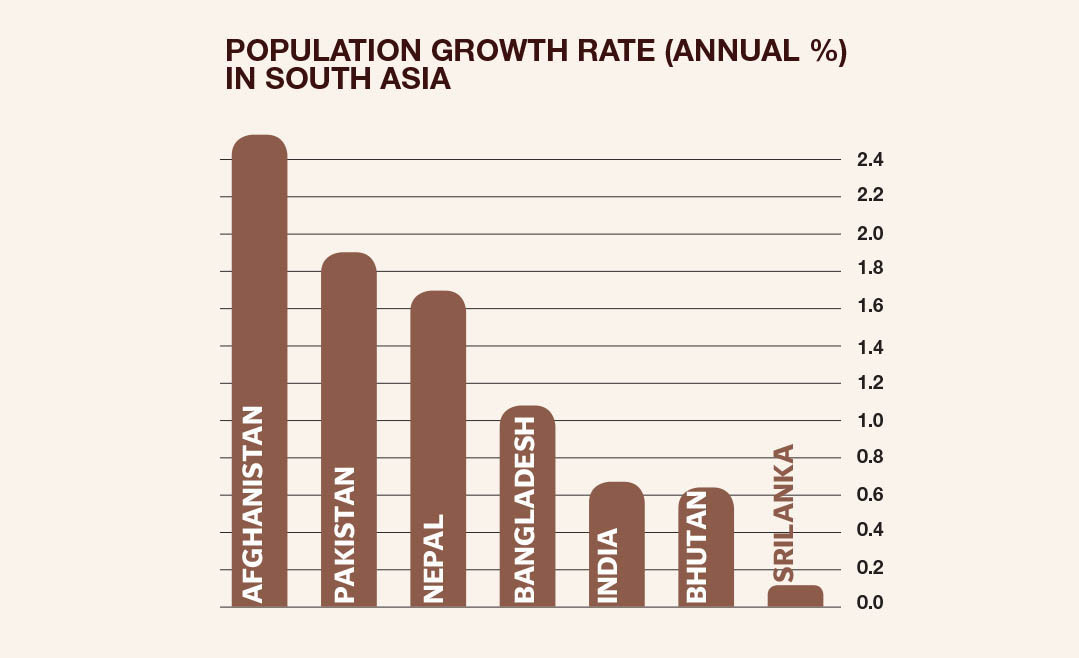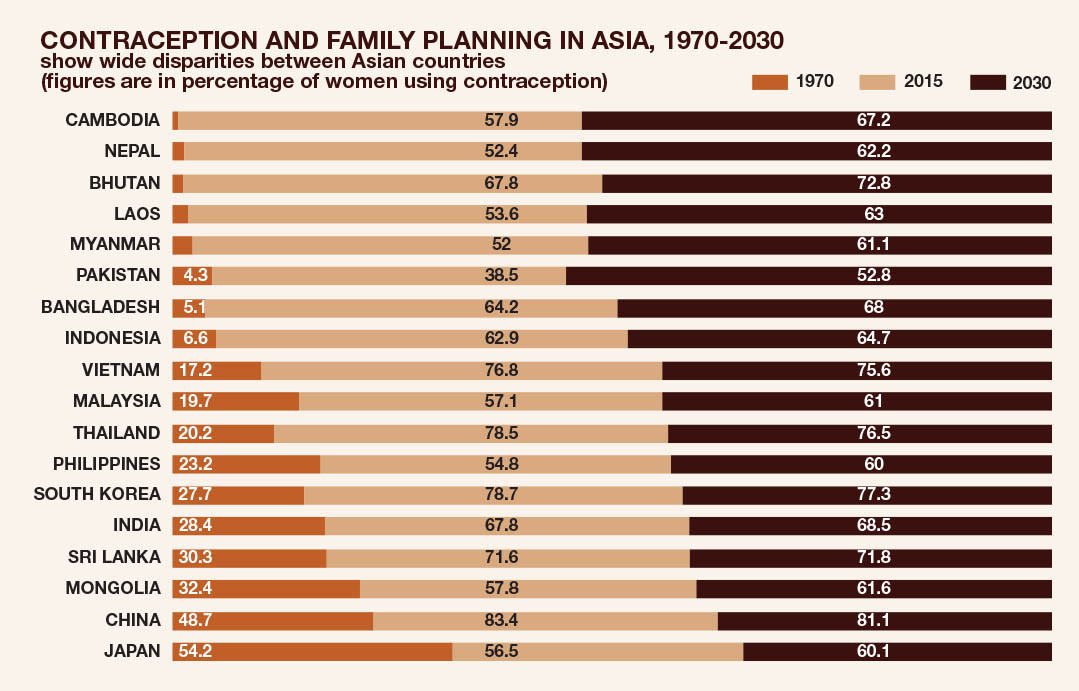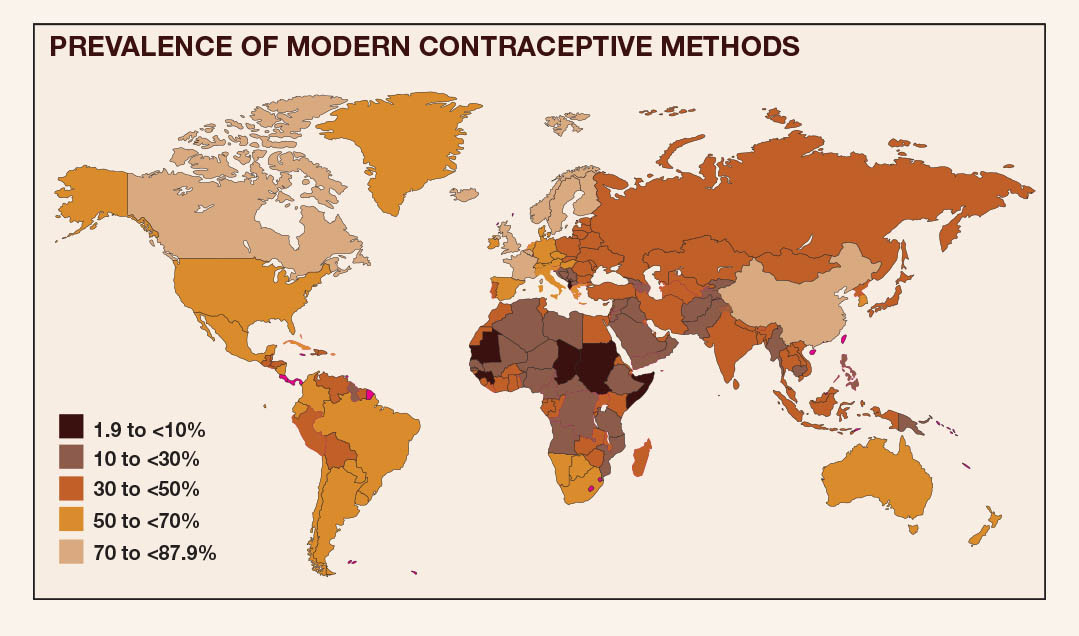A ticking time bomb of population growth threatens Pakistan, joining the league of the world's top five most populous countries, with a staggering 225 million people and counting. The repercussions are hitting hard, straining vital resources, crippling the economy, and overwhelming social infrastructure.
Understanding population growth in Pakistan
Pakistan's population has been experiencing exponential growth over the past few decades. Several factors contribute to this increase including: high birth rates, limited access to family planning services, cultural norms, and religious beliefs. According to the UN, Pakistan's population is projected to reach 403 million by 2050 if the current growth rate continues unchecked.
Population control in Bangladesh
Bangladesh, which shares a similar cultural and historical background with Pakistan, has managed to curb its population growth significantly.
Bangladesh faced a population crisis in the 1970s, with a high fertility rate and a rapidly growing population. The government recognised the need for immediate action and implemented various policies and programmes to address the issue. One of the landmark initiatives, launched in 1976, was the National Family Planning Programme. This programme aimed to provide accessible and affordable family planning services to couples across the country.
Through this initiative, Bangladesh emphasised the importance of family planning, educated the population about contraceptive methods, and made contraceptives readily available. Additionally, the government partnered with non-governmental organisations and community-based groups to create awareness and deliver family planning services effectively.
 Design by : Ibrahim Yahya
Design by : Ibrahim Yahya
Success stories and lessons for Pakistan
Bangladesh's efforts in population control have given rise to remarkable results. From a fertility rate of around 6.3 in the 1970s, the country has successfully reduced it to 2.1, as of the latest available data. This achievement is considered a significant milestone, as a fertility rate of 2.1 is considered the replacement level, where the population size stabilises.
To achieve such success, Bangladesh focused on empowering women and enhancing their access to education and healthcare, leading to an increase in women's participation in the workforce. Educated and empowered women are more likely to make informed decisions regarding family planning, leading to reduced birth rates.
Moreover, Bangladesh's efforts in improving healthcare and reducing child mortality also contributed to population control. When families have confidence in the survival of their children, they tend to have fewer children.
Furthermore, the contraceptive prevalence rate (CPR) in Bangladesh is higher than that of Pakistan. CPR measures the percentage of married or in-union women aged 15 to 49 who are using, or whose sexual partner is using, any method of contraception. Bangladesh's CPR stands at 65.0%, while Pakistan's CPR is 34.1%. This substantial variation reflects the disparity in family planning services and awareness between the two countries.
Challenges Posed by Population Growth in Pakistan
Pakistan's rapid population growth has led to various challenges, including increased pressure on resources, inadequate healthcare facilities, and a strain on educational institutions ― overcrowded classrooms and insufficient resources hinder the delivery of quality education. The demand for food, water, housing, and energy has surged, leading to resource scarcity and environmental degradation.
The healthcare system faces difficulties in providing quality services to the growing population. Maternal and child mortality rates remain high, and the burden of disease has intensified.
 Design by : Ibrahim Yahya
Design by : Ibrahim Yahya
Causes of high population growth in Pakistan
Lack of family planning and birth control The lack of sufficient family planning and birth control measures stands as a significant factor contributing to the country's rapid population growth. A prevalent issue, particularly in rural areas, is the limited awareness and reluctance to adopt modern contraceptive methods. As a result, many families have larger numbers of children than they can adequately support. The absence of accessible family planning services and comprehensive education on reproductive health leads to unintended pregnancies and exacerbates the strain on resources, healthcare, and education systems. Empowering individuals with the knowledge and tools to make informed decisions about family planning will not only help curb the population growth but also improve the overall well-being and prosperity of Pakistan's communities.
High infant mortality rate: Historically, Pakistan has grappled with high infant mortality rates, primarily attributed to limited access to adequate healthcare and sanitation facilities. This unfortunate reality compelled families to have larger numbers of children, as they hoped some would survive to adulthood. While progress has been made in recent years to improve healthcare and reduce infant mortality, this past reality continues to influence population growth patterns. The fear of losing children at a young age still resonates with many families, leading to a preference for larger family sizes as a form of insurance against the uncertainties of infant survival. By ensuring better survival prospects for infants, Pakistan can gradually shift towards a more sustainable population growth trajectory.
Low literacy rate and education: The persistently low literacy rate, particularly among women, plays a significant role in driving higher population growth. The lack of access to education limits individuals' understanding of the importance of family planning and reproductive health. Educated individuals are more likely to comprehend the benefits of smaller family sizes, leading to informed decisions about family planning and birth control. However, the prevailing educational disparities, particularly in rural and marginalised communities, hinder the dissemination of crucial information about reproductive health and family planning. Empowering both men and women with education and knowledge is essential to breaking the cycle of high population growth. By investing in quality education, promoting gender equality, and advocating for comprehensive reproductive health education, Pakistan can pave the way for a more informed and empowered society, contributing to sustainable population management and overall development.
Social and cultural norms: Social and cultural norms have a profound impact on shaping reproductive behaviours, particularly in certain communities where having many children is seen as a symbol of prestige and family honor. These deep-rooted traditions often prioritise larger family sizes, perpetuating the notion that having numerous children signifies prosperity and social standing. Consequently, there is limited acceptance and understanding of family planning methods within these communities. Challenging these norms requires sensitively addressing cultural beliefs and engaging community leaders to promote awareness about the benefits of smaller family sizes and comprehensive family planning. Encouraging open dialogues about reproductive health and breaking the stigma surrounding birth control can empower individuals to make informed choices about their family size, contributing to a more sustainable population growth in Pakistan. By combining culturally sensitive approaches with education and advocacy, the nation can gradually shift away from excessive population growth and foster a society where reproductive decisions are based on informed choices rather than social pressures.
Religious beliefs and practices: In Pakistan, religious beliefs and practices play a significant role in influencing population growth. As a country where religion holds immense significance in the lives of its people, certain interpretations of religious teachings may encourage larger families. Some religious beliefs emphasise the importance of procreation and view children as a blessing and a source of divine favor. Consequently, these interpretations may contribute to a cultural preference for larger family sizes within religious communities. It is essential to recognise the sensitivity of religious beliefs and engage in constructive dialogues to promote understanding about family planning and reproductive health. By fostering a balanced approach that respects religious values while also advocating for informed reproductive choices, Pakistan can work towards addressing population growth in a way that is culturally respectful and sustainable. Education and awareness campaigns can play a crucial role in highlighting the importance of family planning and empowering individuals to make decisions that align with their religious beliefs and personal circumstances.
 Design by : Ibrahim Yahya
Design by : Ibrahim Yahya
Effects of high population growth
The rapid increase in population has various consequences for Pakistan:
Pressure on resources With expanding population, the demand for essential resources such as water, food, and energy has reached unprecedented levels, exerting immense strain on the country's already limited natural reserves. The growing needs of its people are putting a considerable burden on the infrastructure and the environment, threatening the sustainability and equilibrium of vital ecosystems.
Unemployment and poverty The challenge of high population growth exacerbates the pressing issues of unemployment and poverty. With a rapidly expanding workforce, the economy finds it increasingly difficult to generate enough jobs to accommodate the influx of job seekers. As a result, unemployment rates soar, leaving a significant portion of the population struggling to secure stable and dignified livelihoods. The lack of employment opportunities directly contributes to the persistence of poverty, trapping many individuals and families in a cycle of economic hardship.
Strain on healthcare and education The escalating population places considerable strain on the healthcare system and education infrastructure, posing significant challenges in providing essential services to all citizens. As the population expands, the demand for healthcare services increases, stretching the already limited resources and facilities to their limits. Access to quality healthcare becomes more difficult for many, particularly in remote and underserved areas, leading to disparities in healthcare outcomes. Similarly, the education sector faces similar challenges, with a surge in the number of students overwhelming schools and colleges. As a result, maintaining the standard of education becomes a daunting task, hindering the country's ability to provide equal educational opportunities to all.
Environmental impact The mounting population has significant environmental implications, giving rise to increased waste generation and pollution, which, in turn, exacerbates environmental degradation and contributes to the effects of climate change. With more people producing waste and demanding resources, the pressure on natural ecosystems intensifies. Improper waste management practices strain the environment, as landfills overflow and pollution contaminate air, water, and soil.
The accelerated pace of urbanisation further encroaches on green spaces and exacerbates deforestation, threatening biodiversity and ecological balance. Moreover, the escalating emissions from industries, transportation, and energy consumption contribute to climate change, resulting in extreme weather events, erratic rainfall patterns, and rising temperatures. Addressing these environmental challenges requires a concerted effort from the government, industries, and individuals to adopt sustainable practices, promote renewable energy, implement effective waste management systems, and foster environmental awareness and conservation efforts to safeguard Pakistan's natural heritage for future generations.
 Design by : Ibrahim Yahya
Design by : Ibrahim Yahya
Policies to counteract underlying causes of high population growth in Pakistan
Family planning and awareness programmes: To control population growth effectively, Pakistan must prioritize family planning and create awareness about its benefits. Family planning allows individuals to make informed choices regarding the number and spacing of their children, leading to healthier and more sustainable families.
Educational campaigns on family planning, contraception, and reproductive health should be promoted through various media platforms and community outreach programs. Engaging religious leaders and influencers in these campaigns can help dispel misconceptions and myths surrounding family planning methods.
Women empowerment and reproductive rights: When women are educated, financially independent, and have access to reproductive healthcare, they can make informed decisions about their reproductive choices. Investing in women's education and healthcare is an investment in the future of the country. Furthermore, ensuring women's reproductive rights is essential for population control. Women should have the right to decide when and how many children they want to have, empowering them to break free from traditional norms and achieve their aspirations.
Healthcare and child mortality: Pakistan must invest in improving healthcare infrastructure, ensuring access to quality healthcare services for all citizens, especially in rural areas. Reducing child mortality rates is directly linked to population control. When families are assured of their children's survival, they are more likely to have fewer children. Pakistan can learn from Bangladesh's successful efforts in reducing child mortality and implement similar strategies to achieve positive outcomes.
Economic implications of population growth: Population growth has significant economic implications for Pakistan. A rapidly growing population poses challenges to economic development, as the demand for jobs and resources increases. Investing in education, skill development, and job creation is essential to harnessing the demographic dividend.
Urbanisation and rural development: Balancing urban and rural development is crucial to controlling population growth. Providing adequate opportunities and facilities in rural areas can discourage mass migration to urban centers. This balanced approach ensures that resources are distributed more equitably, leading to a more stable population growth pattern.
The take home
Knowledge holds the key to recognising the severity of Pakistan's population challenge and aiding the government in tackling this critical issue. Women's empowerment emerges as a potent force in curbing population growth rates, while raising literacy levels is crucial to achieving our population control goals. Singapore and China's successful adoption of two-child and one-child policies offer valuable lessons. To combat poverty, disparity, and other pressing problems, Pakistan must prioritise population regulation as the initial step. Meaningful discussions on family planning are imperative. Our resources are depleting, cities overcrowded and polluted, and the environment deteriorating. Pakistan's multiple woes, from poverty to climate change, are exacerbated by unchecked population growth. We must act now to unlock Pakistan's potential and address the social and economic challenges that lie ahead.
